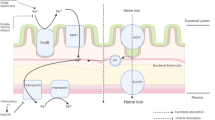Abstract
Iron deficiency occurs frequently in pregnancy and can be diagnosed by serum ferritin-level measurement (threshold value < 30 μg/L). Screening for iron-deficiency anemia is recommended in every pregnant women, and should be done by serum ferritin-level screening in the first trimester and regular hemoglobin checks at least once per trimester. In the case of iron deficiency with or without anaemia in pregnancy, oral iron therapy should be given as first-line treatment. In the case of severe iron-deficiency anemia, intolerance of oral iron, lack of response to oral iron, or in the case of a clinical need for rapid and efficient treatment of anaemia (e.g., advanced pregnancy), intravenous iron therapy should be administered. In the postpartum period, oral iron therapy should be administered for mild iron-deficiency anemia (haemorrhagic anemia), and intravenous iron therapy for moderately severe-to-severe anemia (Hb < 95 g/L). If there is an indication for intravenous iron therapy in pregnancy or postpartum, iron-containing drugs which have been studied in well-controlled clinical trials in pregnancy and postpartum such as ferric carboxymaltose must be preferred for safety reasons. While anaphylactic reactions are extremely are with non-dextrane products, close surveillance during administration is recommended for all intravenous iron products.
Similar content being viewed by others
References
WHO Global Database. Worldwide prevalence of anemia 1993–2005; 2008
Bencaiova G, Breymann C (2014) Mild anemia and pregnancy outcome in a Swiss collective. J Pregnancy 2014:307535
Hercberg S, Preziosi P, Galan P (2001) Iron deficiency in Europe. Public Health Nutr 4:537–545
Allen LH (1997) Pregnancy and iron deficiency: unresolved issues. Nutr Rev 55(4):91–101
Breymann C (2015) Anemia and iron deficiency anemia in gynecology and obstetrics, vol 1. Bremen
Murray-Kolb L (2012) Maternal mortality, child mortality, perinatal mortality, child cognition, and estimates of prevalence of anemia due to iron deficiency. CHERG
Rondo P, Tomkins A (1999) Maternal iron status and intrauterine growth retardation. Trans RS Trop Med 93:423–426
Gibson RS (1990) Assessment of iron status. Principles of nutritional assessment. Oxford University Press, Oxford, pp 349–376
Milman N, Agger A, Nielson O (1991) Iron supplementation during pregnancy. Dan Med Bull 38:471–476
Milman N, Graudal N, Agger A (1995) Iron status markers during pregnancy: no relationship between levels at the beginning of the second trimester, prior delivery and post partum. J Int Med 237:261–267
Krafft A, Breymann C (2004) Haemoglobinopathy in pregnancy: diagnosis and treatment. Curr Med Chem 11(21):2903–2909
Breymann C, Bian XM, Blanco-Capito LR, Chong C, Mahmud G, Rehman R (2011) Expert recommendations for the diagnosis and treatment of iron-deficiency anemia during pregnancy and the postpartum period in the Asia-Pacific region. J Perinat Med 39(2):113–121
Breymann C, N NM, Mezzacasa A, Bernard R, Dudenhausen J, investigators F-A (2016) Ferric carboxymaltose vs. oral iron in the treatment of pregnant women with iron deficiency anemia: an international, open-label, randomized controlled trial (FER-ASAP). J Perinat Med (epub ahead of print)
Christoph P, Schuller C, Studer H, Irion O, Tejada BD, Surbek D (2012) Intravenous iron treatment in pregnancy: comparison of high-dose ferric carboxymaltose vs. iron sucrose. J Perinat Med 13(40):469–474
Froessler B, Cocchiaro C, Saadat-Gilani K, Hodyl N, Dekker G (2013) Intravenous iron sucrose versus oral iron ferrous sulfate for antenatal and postpartum iron deficiency anemia: a randomized trial. J Matern Fetal Neonatal Med 26(7):654–659
Froessler B, Collingwood J, Hodyl NA, Dekker G (2014) Intravenous ferric carboxymaltose for anaemia in pregnancy. BMC Pregnancy Childbirth 14:115
Gupta A, Manaktala U, Rathore AM (2014) A randomised controlled trial to compare intravenous iron sucrose and oral iron in treatment of iron deficiency anemia in pregnancy. Indian J Hematol Blood Transfus 30(2):120–125
Breymann C, Gliga F, Bejenariu C, Strizhova N (2008) Comparative efficacy and safety of intravenous ferric carboxymaltose in the treatment of postpartum iron deficiency anemia. Int J Gynaecol Obstet 101(1):67–73
Rathod S, Samal SK, Mahapatra PC, Samal S (2015) Ferric carboxymaltose: a revolution in the treatment of postpartum anemia in Indian women. Int J Appl Basic Med Res 5(1):25–30
Gravier A (1999) Avoiding postpartum transfusions: the utility of intravenous iron supplementation (translation). J Gynecol Obstet Biol Reprod 28:77–78
Muñoz M, Breymann C, García-Erce J, Gómez-Ramírez S, Comin J, Bisbe E (2008) Efficacy and safety of intravenous iron therapy as an alternative/adjunct to allogeneic blood transfusion. Vox San 94(3):172–183
Gupta A, Rathore AM, Manaktala U, Gupta A, Gupta S (2015) Role of intravenous iron sucrose in correction of anemia in antenatal women with advanced pregnancy. Indian J Hematol Blood Transfus 31(2):251–254
Author information
Authors and Affiliations
Corresponding author
Ethics declarations
Funding
This study was funded by the Swiss Society of Gynecology and Obstetrics (SSGO).
Conflict of interest
C. Breymann has received speaker and workshop honorarium, and clinical study support from Vifor Inc. C. Honegger declares that he has no conflict of interest. I. Hösli has received speaker honorarium from Vifor Inc. D. Surbek has received speaker honorarium and an unrestricted grant for a investigator-initiated study from Vifor Inc.
Ethical approval
This article does not contain any studies with human participants or animals performed by any of the authors.
This expert recommendation has been reviewed by the members of the Quality assurance committee of the SSGO. The Quality Assurance Committee of gynécologie suisse/SGGO (Swiss Society of Obstetrics and Gynaecology) compiles guidelines and expert letters with utmost care. However, the Quality Assurance Committee of gynécologie suisse/SGGG accepts no responsibility for the correctness and completeness of the content. The manufacturer’s instructions must be observed at all times, in particular the dosage instructions. To the Committee’s best knowledge, guidelines and expert letters correspond to the latest scientific insights at the time of publication. Users must take intervening changes into account.
Additional information
Expert panel recommendation from the Quality Assurance Committee, Swiss Society of Gynecology and Obstetrics SSGO.
Rights and permissions
About this article
Cite this article
Breymann, C., Honegger, C., Hösli, I. et al. Diagnosis and treatment of iron-deficiency anaemia in pregnancy and postpartum. Arch Gynecol Obstet 296, 1229–1234 (2017). https://doi.org/10.1007/s00404-017-4526-2
Received:
Accepted:
Published:
Issue Date:
DOI: https://doi.org/10.1007/s00404-017-4526-2




